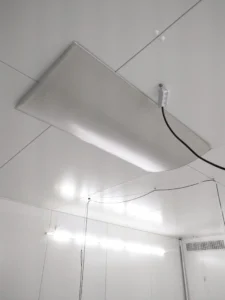 InfrarotHeizkosten und Wirkungsgrad [AI**]
InfrarotHeizkosten und Wirkungsgrad [AI**]It is striking: only for infrared heaters is there a German industrial standard (DIN) that determines how efficient an infrared heater is. There is no standard for all other types of heaters. The basics:
Sunlight, the strongest source of infrared light, sends its rays with high energy to the earth and generates heat there. The efficiency of this primary energy is almost 99%. Infrared rays travel billions of light years through space without loss.
Due to the losses incurred when converting electricity into heat, the latest infrared heaters physically achieve a maximum efficiency of 70% (± 2.8%). A high efficiency is important. It is the first decision criterion for energy-saving heating.
AbegSun has Testing according to DIN EN IEC 60675-3 at the TU Dresden achieved a peak value of 69.5% (± 2.8%) and was rated as one of the most efficient infrared heating elements.
Changes in material and aggregate state, e.g. the conversion of electricity into heat or the transfer of heat to sheet metal, glass, slate or marble, always cost energy. Even painting causes losses. If an efficiency of almost 100 % is quoted for infrared heaters, this is wrong. It is confused with the efficiency of primary energy - see below ↓ …..
A distinction is made between different types of energy when determining efficiency:
Primary energy – these include coal, wood, natural gas, petroleum, nuclear fuel, peat and renewable energy sources.
Secondary energy – in refineries or power plants it is produced from primary energy by converting the state of aggregation, e.g. petrol or electricity.
Final energy - This can already be utilised by the consumer. It is lower than secondary energy due to conversion, transmission and utilisation losses.
Useful energy – this is the energy that is available to the end user after conversion from final energy to a heating system in a room. The useful energy is less than the final energy because the conversion of energy from final energy involves losses.
The amount of energy available can be determined by calculating the efficiency. According to the DIN EN IEC 60675-03 In Germany, the efficiency is tested and calculated by the TU Dresden and given as a % value.
The efficiency is always less than 100% due to conversion losses. Losses occur when changing states of matter, e.g. from liquid to gaseous or when converting electrical energy into heat energy. This is why a maximum value of 70% (± 2.8%) can be achieved with infrared heaters (statement from the TU Dresden in accordance with DIN). Maximum efficiency is the basic requirement for the lowest possible energy consumption. It is the most important base value for determining the efficiency of a heating system.
The heating efficiency of the AbegSun infrared heating elements of 69.5% (± 2.8%) has also been verified in practice. Look at the results of a daily consumption measurement ……..
This DIN standard exists for infrared heaters, but not for heat pump systems, for example. Instead, the plumbing and heating industry has defined its own values. These are misused in advertising statements, usually by laypeople.
They say that 3-5 times more energy is gained than was supplied. If that were the case, we would no longer have energy problems in the world, but would have invented a perpetual motion machine. Therefore, everyone should remember that a wrong decision about the length of heating periods lasting years can cost a huge amount of money! Siehe auch “Unsere Philosophie” ………


Of all the types of heating, infrared heating is the only one for which there is a set test according to DIN to determine efficiency. The picture on the left shows an AbegSun heating element during the efficiency test at the TU Dresden.
Bei jeder Heizung gibt es zwischen der Eingangsenergie und der nutzbaren Endenergie physikalische Verluste, die nicht zu vermeiden sind. Jeder Wechsel des Aggregatzustandes, von fest zu flüssig oder von Strom zu Wärme vermindert den Wirkungsgrad; jeder Materialwechsel bei dem die Energie übertragen werden muss, ebenfalls.
Darum liegt die physikalisch maximal erreichbare Grenze bei Infrarot Heizelementen laut Aussage von Wissenschaftlern und Festlegung in der DIN bei max. 70 % (± 2,8%).
AbegSun hat laut DIN 69,5 % (± 2,8%) Wirkungsgrad (von 70% physikalisch erreichbaren). Darum zählt die AbegSun Infrarotheizung zu den effizientesten der Welt. Das bedeuted, dass man damit die Möglichkeit gegeben ist, die geringesten Energiekosten zu erreichen. Diese werden nur noch durch das eigene Heizverhalten positiv oder negativ beeinflusst.
Der preisgünstigste Heizkörper ist immer der mit dem höchsten Wirkungsgrad – unabhängig von den Anschaffungskosten! (Table with energy losses at poor efficiency –>)

LEGAL MATTERS
Imprint
Privacy policy
AGB
REPEAL
Instruction
Explanation
INFORMATION
Efficiency
WEEE registry


This website uses cookies to improve your experience. We'll assume you're ok with this, but you can opt-out at any time if you wish. Read more
| Name | Domain | Purpose | Procedure | Typ |
|---|---|---|---|---|
| _ga | abeg.de | Google Universal Analytics long-time unique user tracking identifier. | 2 years | HTTP |
| sbjs_migrations | abeg.de | Sourcebuster tracking cookie | 55 years | HTTP |
| sbjs_current_add | abeg.de | Sourcebuster tracking cookie | 55 years | HTTP |
| sbjs_first_add | abeg.de | Sourcebuster tracking cookie | 55 years | HTTP |
| sbjs_current | abeg.de | Sourcebuster tracking cookie | 55 years | HTTP |
| sbjs_first | abeg.de | Sourcebuster tracking cookie | 55 years | HTTP |
| sbjs_udata | abeg.de | Sourcebuster tracking cookie | 55 years | HTTP |
| sbjs_session | abeg.de | SourceBuster Tracking session | Session | HTTP |
| tk_or | abeg.de | JetPack analytical cookie that stores a randomly-generated anonymous ID. This is only used within the admin area and is used for general analytics tracking. | 5 years | HTTP |
| tk_r3d | abeg.de | JetPack analytical cookie that stores a randomly-generated anonymous ID. This is only used within the admin area and is used for general analytics tracking. | 3 days | HTTP |
| tk_lr | abeg.de | JetPack analytical cookie that stores a randomly-generated anonymous ID. This is only used within the admin area and is used for general analytics tracking. | 1 year | HTTP |
| tk_ai | abeg.de | JetPack analytical cookie that stores a randomly-generated anonymous ID. This is only used within the admin area and is used for general analytics tracking. | 5 years | HTTP |
| tk_qs | abeg.de | JetPack analytical cookie. This is used for general analytics tracking. | Session | HTTP |
| IDE | doubleclick.net | Google advertising cookie used for user tracking and ad targeting purposes. | 2 years | HTTP |
| Name | Domain | Purpose | Procedure | Typ |
|---|---|---|---|---|
| __cf_bm | chatgpt.com | Generic CloudFlare functional cookie. | Session | HTTP |
| __cflb | chatgpt.com | Generic CloudFlare functional cookie. | Session | HTTP |
| Name | Domain | Purpose | Procedure | Typ |
|---|---|---|---|---|
| _ga_KHX87M29Q7 | abeg.de | --- | 2 years | --- |
| _ga_DSRJTX116M | abeg.de | --- | 2 years | --- |
| _gcl_au | abeg.de | --- | 3 months | --- |
| test_cookie | doubleclick.net | Google advertising domain. | Session | HTTP |


